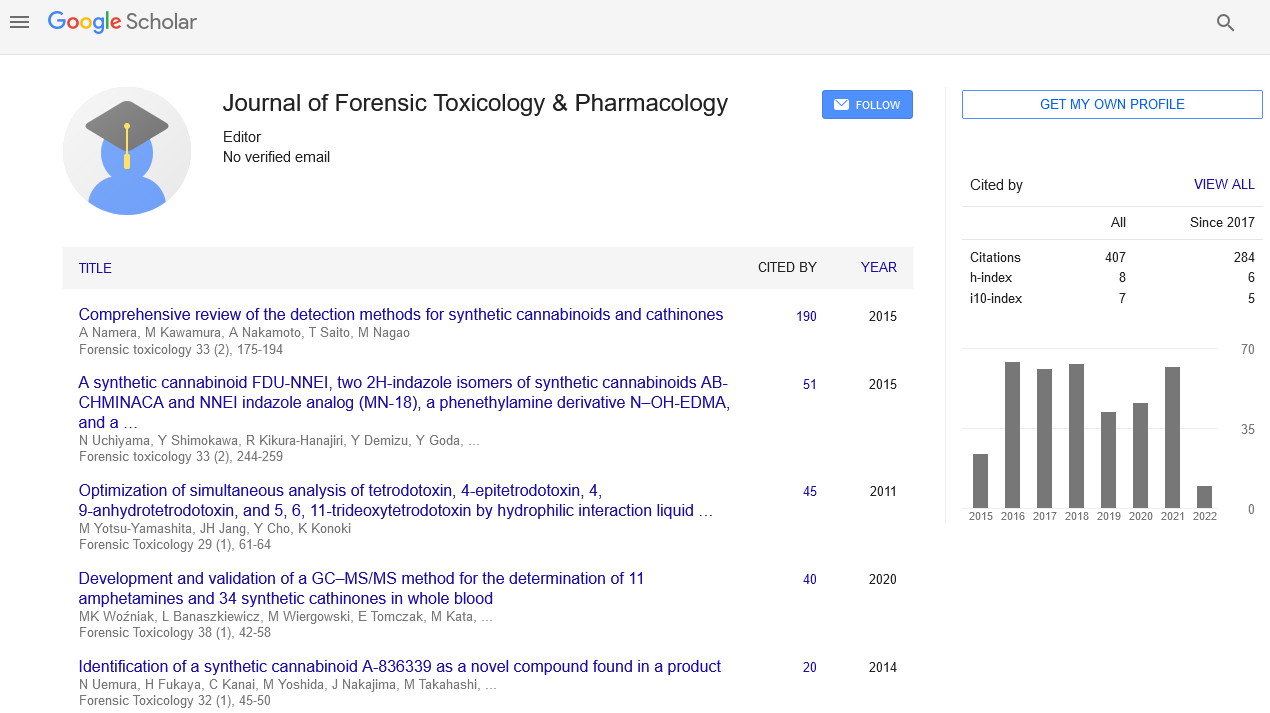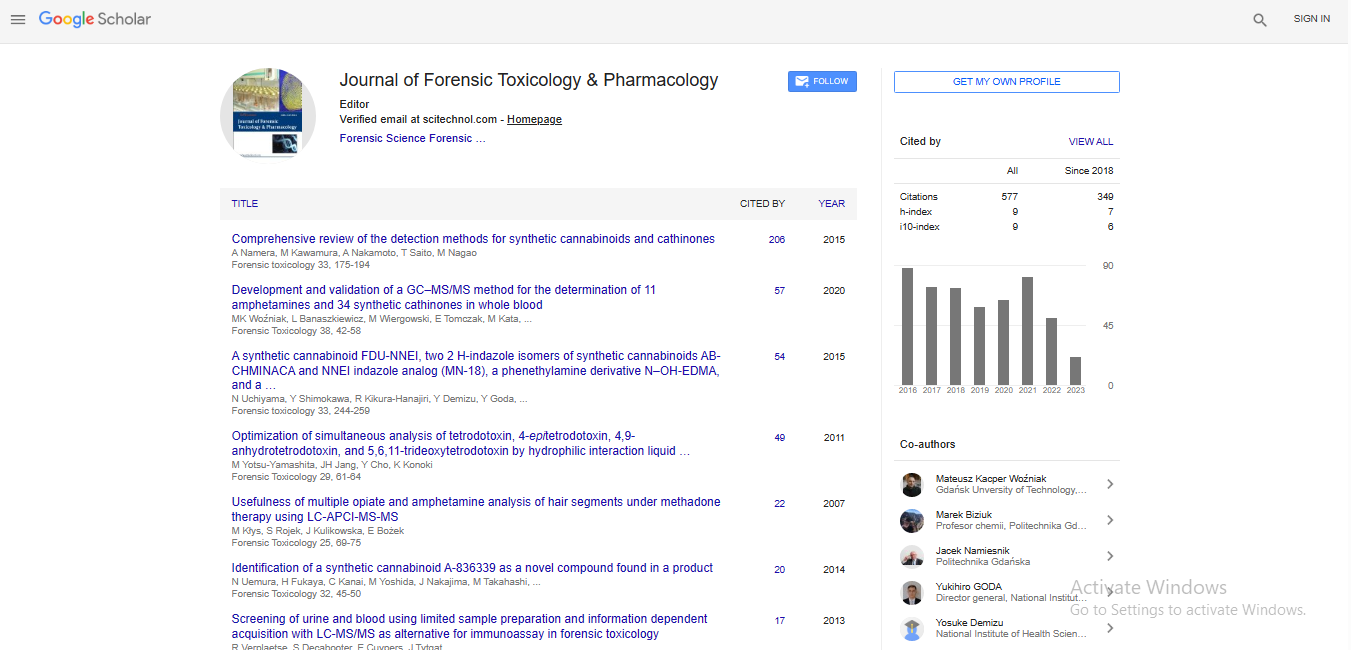Perspective, J Forensic Toxicol Pharmacol Vol: 13 Issue: 3
Chemical Warfare Agents and Antidotes: Advances in Toxicology and Pharmacology of Emergency Treatments
Irina Petrova*
1Department of Pharmacology and Toxicology, Lomonosov Moscow State University, Moscow, Russia
*Corresponding Author: Irina Petrova,
Department of Pharmacology and
Toxicology, Lomonosov Moscow State University, Moscow, Russia
E-mail: petrovairina@gmail.com
Received date: 26 August, 2024, Manuscript No. JFTP-24-151884;
Editor assigned date: 28 August, 2024, PreQC No. JFTP-24-151884 (PQ);
Reviewed date: 11 September, 2024, QC No JFTP-24-151884;
Revised date: 18 September, 2024, Manuscript No. JFTP-24-151884 (R);
Published date: 25 September, 2024, DOI: 10.4172/JFTP.1000196
Citation: Petrova I (2024) Chemical Warfare Agents and Antidotes: Advances in Toxicology and Pharmacology of Emergency Treatments. J Forensic Toxicol Pharmacol 13:3.
Description
Chemical Warfare Agents (CWAs) have posed significant threats to public safety for over a century. The destructive impacts of these toxic agents confirm the need for timely and effective treatments in emergency scenarios. Advances in toxicology and pharmacology have spurred new insights into how we can reduce the risks of CWAs, offering essential information on identifying the agents and administering antidotes rapidly.
CWAs include a broad spectrum of toxic compounds, such as nerve agents, blister agents, blood agents and choking agents. Each category affects the human body differently, making it important to recognize the symptoms and understand their mechanisms. Nerve agents, for example, disrupt the nervous system by inhibiting acetylcholinesterase, leading to overstimulation of muscles, glands and other tissues. Blister agents like sulfur mustard damage skin and respiratory organs, causing severe burns and blisters. Blood agents, such as cyanide, interfere with oxygen use at the cellular level, while choking agents like chlorine affect the respiratory system.
Recent advances have focused on understanding CWAs at the molecular level, allowing for better identification of how these agents interact with biological systems. Pharmacological research now targets the specific pathways affected by each agent type. Understanding these pathways has led to the development of novel compounds capable of neutralizing toxic effects or slowing their progression, helping emergency responders administer more effective treatments.
These insights have also contributed to refining existing antidotes and improving the delivery methods of these treatments. For example, atropine is widely used for nerve agent exposure, blocking the effects of excess acetylcholine. Pralidoxime chloride (2-PAM) reactivates acetylcholinesterase, making it essential in managing nerve agent poisoning. In recent years, new formulations of atropine and 2-PAM have emerged to improve their stability and absorption, making them easier to administer in fast-paced emergency environments.
Antidotal therapies continue to evolve with a focus on safety and speed. In emergency settings, rapid administration is essential to prevent the onset of severe symptoms. Auto-injectors for atropine and 2-PAM, for instance, allow for quick administration in the field, reducing the delay in treatment. Research has also analyzed the use of adjunct therapies to enhance the effectiveness of primary antidotes. Studies indicate that combining anticonvulsants with antidotes can improve patient outcomes by controlling seizures often triggered by nerve agents.
Efforts to improve accessibility and training for medical personnel have also emerged as vital. Medical professionals are now trained to recognize the early signs of CWA poisoning and apply treatments more effectively. This shift towards comprehensive training programs is essential, especially in regions where the risks of chemical attacks are higher. Emergency responders can now access online platforms and simulation tools that offer realistic training in handling CWA incidents. These platforms enhance readiness, ensuring that responders are equipped with the knowledge and skills needed to manage CWA exposure.
Progress in toxicology and pharmacology has led to meaningful improvements in the treatment and management of chemical warfare agent exposure. By understanding the biochemical mechanisms underlying each type of agent, researchers have developed new antidotes, improved existing ones and optimized delivery systems to provide faster and safer emergency responses. Continued advancements will be critical for ensuring that healthcare professionals and emergency responders are prepared to protect public health in the face of CWA threats. Through a combination of scientific exploration and practical training, we move closer to achieving effective defense strategies against these hazardous agents.
 Spanish
Spanish  Chinese
Chinese  Russian
Russian  German
German  French
French  Japanese
Japanese  Portuguese
Portuguese  Hindi
Hindi 
